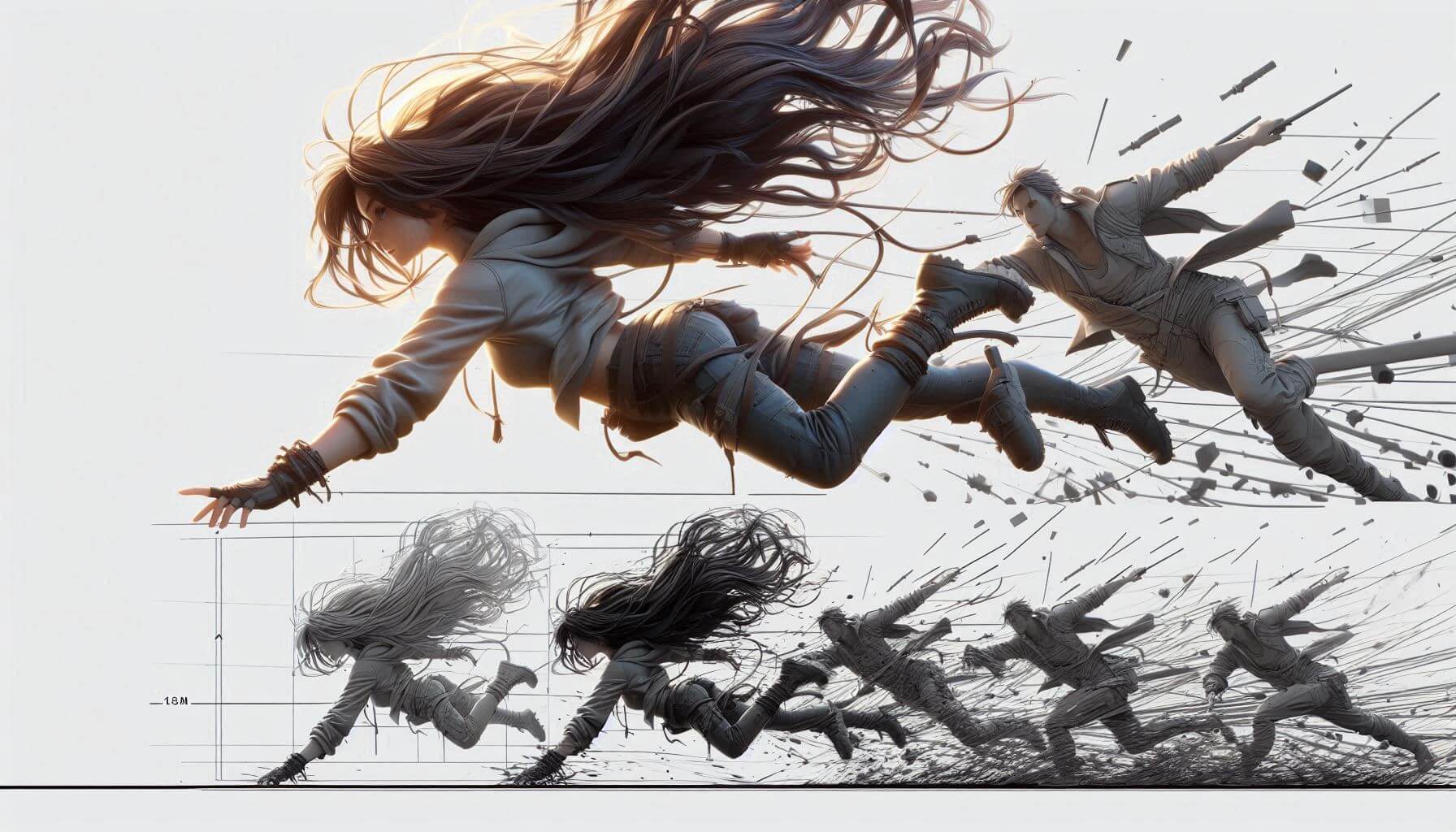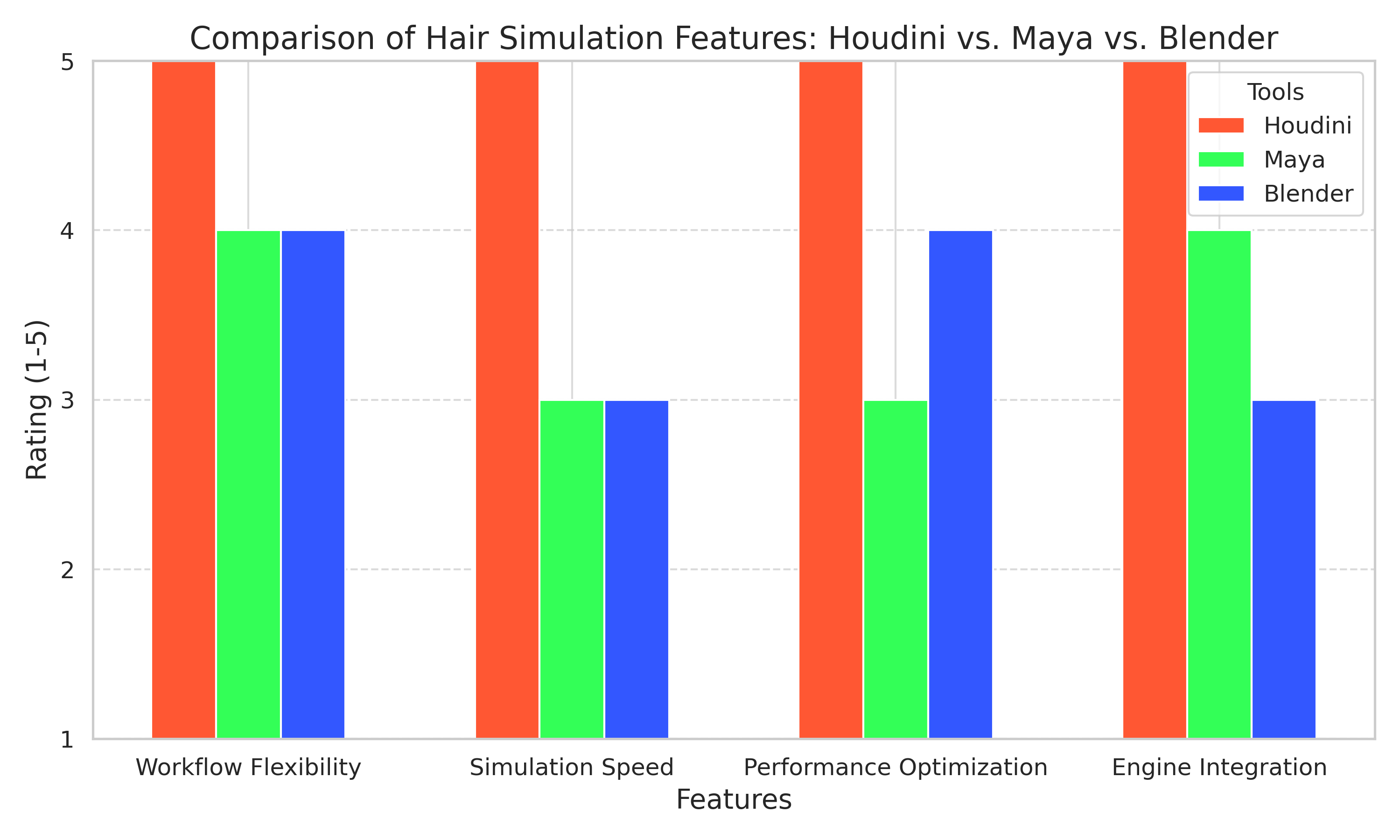In the ever-evolving world of video game development, one of the most intricate challenges developers face is simulating realistic hair movement in real-time environments. Hair simulation in games significantly impacts character design, enhancing realism and player immersion. As gaming technology advances, especially with the introduction of next-gen consoles and powerful engines like Houdini hair simulation, we’re seeing remarkable progress in how hair is simulated and rendered in games.
Gone are the days when game characters sported static, plastic-like hair that remained unmoved regardless of action or environment. Today’s gamers expect characters’ hair to respond naturally to gravity, movement, wind, and interactions, which must be accurately replicated in real time to maintain immersion. Achieving this level of quality in hair simulation in games requires software that is robust in simulation capabilities and optimized for performance. Houdini hair simulation capabilities bridge the gap between pre-rendered cinematics and real-time gameplay, elevating the possibilities for realistic hair animation in games.
At the heart of Houdini’s hair dynamics lies its node-based procedural workflow. Unlike traditional tools, Houdini hair simulation uses interconnected nodes, making it easy for artists to create complex hair animations that adapt to diverse character types and scenes. This flexible approach allows for quick changes without restarting it from scratch, giving artists more freedom to experiment and fine-tune their work.
Houdini’s hair simulation system stands out with powerful grooming tools that make realistic hair creation easier:
Guide curves in Houdini offer artists precise control over hair flow and shape, simplifying the complexity of realistic hair simulation. By adjusting parameters such as density, stiffness, and noise for each guide curve, artists can fine-tune the hair’s movement and distribution more accurately. This allows creators to define overall direction, volume, and style, affecting thousands of strands to follow the intended pattern. With these adjustable controls, artists can achieve complex hairstyles—like sweeping locks and intricate braids—without manually positioning each hair, making it a powerful tool for efficiently crafting expressive, lifelike hair.
Layered grooming allows artists to make hair in multiple stages, each serving a specific purpose. Base layers can be added for general volume, giving the hair its foundational shape. Then, additional fill layers can be blended to add density, creating a fuller look. Finally, detail layers provide finesse, adding subtle strands that bring realism and complex detailing. This modular approach allows artists to focus on one aspect of the hairstyle at a time, guaranteeing that each layer contributes to an overall natural and realistic result. Layered grooming also makes it easier to revise individual elements without disrupting the entire look, improving control and creative freedom.
Clumping control allows artists to group hair strands into realistic clusters, imitating hair’s natural movement to gather in small, irregular sections. This feature allows the formation of clusters of differing sizes and shapes, creating a more real appearance by avoiding the uniformity often seen in digital hair. Artists can adjust clumps’ amount, size, and randomness to make the hair look messy or smooth. Clumping control is important for achieving the natural differences in real hair, especially for styles with curls, waves, or layered textures, as it brings an organic, unstructured quality that closely mirrors reality.
Randomization tools are essential in avoiding the mechanical repetition that can make digitally generated hair look artificial. By introducing subtle riffs in strand length, thickness, and positioning, these tools create a sense of natural diversity within the hairstyle. Artists can use randomization settings to control patterns from forming, which would otherwise distract from realism. This feature assures that even when strands are designed to follow a specific style or flow, they possess slight irregularities that make them look alive and textured. The result is hair that appears more naturally assorted and less like a static object, improving the immersive quality of digital characters.

One of the critical creations in Houdini hair dynamics is its mass-spring system implementation, which lets the hair maintain a default pose while accurately handling collisions with the character’s head. This system is reliable even at lower frame rates, ensuring smooth game performance. This is achieved through:
The Vellum solver in Houdini is a powerful tool for simulating hair dynamics in real-time, allowing hair to react naturally to character movements and environmental factors. Using physics-based simulations, the Vellum solver can mimic how hair moves, bends, and interacts with surrounding objects, adding a layer of reality that improves character immersion. This solver is particularly adept at handling short-hair simulations, which require fine control over subtle movements and spring-like behaviors. Its efficiency allows for smooth performance even when dealing with complex issues between hair and other elements, such as clothing or props, making it an ideal choice for producing lifelike hair dynamics in animation and gaming.
Hair cards are a practical way to represent hair in real-time game engines without the heavy processing of simulating each strand. These flat, polygon-based cards look like hair but are much easier for the system to handle. In Houdini, artists can quickly create hair cards from their hair designs, making it easy to prepare detailed hair for games. Hair cards work well in Unreal Engine and Unity, helping games run smoothly while still looking great. This method provides a good mix of realistic visuals and efficient performance, perfect for interactive settings.
Houdini’s workflow effortlessly connects with significant game engines through:
Houdini makes converting complex hair simulations into game-ready assets accessible by automatically creating hair cards from detailed hair designs. These hair cards keep the look of the hair but use much fewer resources, which is ideal for games. Instead of individually rendering every strand, these flat shapes act as simplified versions of the hairstyle. This process allows artists to bring their elaborate hair designs into games without heavy processing demands, maintaining a realistic look while making it manageable for real-time environments.
After grooming and simulating hair in Houdini, the assets can be exported as low-poly models, which are lighter and more accessible for game engines to handle. Using additional tools like Substance Designer, artists can create detailed textures and opacity maps that add depth and realism to the hair without slowing down the game’s performance. This export process ensures that the hair looks sharp and lifelike in the game while still being optimized enough for smooth, real-time gameplay.
Once the hair assets are ready, they can be imported into game engines like Unreal Engine or Unity, where they’re rendered in real-time. This means players can see hair that moves naturally and interacts with the character’s movements as they play. Real-time rendering brings a lifelike quality to the hair, creating a more immersive experience where the character’s hair flows and shifts in response to in-game actions.
Compared to other software like Maya or Blender, Houdini offers unique, advanced features that are well-suited for Virtual Reality Solutions and gaming, making it an ideal choice for high-quality results.

The future of hair physics in gaming looks promising, with Houdini leading the charge:
As GPU technology and rendering techniques advance, we can expect even more realistic hair simulations that respond to environmental changes, lighting, and movement with greater detail. These improvements will enrich player immersion by making virtual characters and environments more lifelike and dynamic.
Houdini hair dynamics tools are becoming increasingly user-friendly, allowing indie developers with limited resources to implement high-quality simulations. As the software evolves, more tutorials presets, and streamlined workflows will make it easier for a broader range of creators to achieve professional-grade results without the steep learning curve typically associated with high-end tools.
Houdini is developing better solutions for optimizing hair simulations and assets across various platforms, including VR, Real Estate, and mobile. By improving performance and making sure that assets are efficiently rendered, Houdini allows for effortless experiences across different devices and use cases, making it a versatile tool for diverse industries beyond gaming.
Integrating AI-driven solutions in Houdini’s hair simulation framework represents a transformative approach. Neural flow maps are being developed to store and process spatiotemporal data, as seen in our simulation-based banking case studies, using machine learning models, which promise to improve simulation accuracy and computational efficiency.
At Juego Studios, we recognize the pivotal role that advanced hair simulation plays in advancing gaming experiences. Our skilled artists and developers harness Houdini’s ability to create stunning, lifelike characters, bringing enriched realism to PC and console gaming. As a leader among game animation studios with Houdini expertise, we push the boundaries of game development. Whether you’re looking to upgrade your game with dynamic hair movements or explore the latest in procedural modeling, our expertise can help you achieve your vision.
Houdini’s hair simulation is a big step forward in gaming graphics, combining powerful tools, streamlined workflows, and real-time capabilities essential for today’s games. As hardware improves, Houdini will keep pushing the limits of real-time hair simulation, opening new possibilities for immersive, visually rich gaming experiences. The future of game graphics is here, taking hair realism to the next level.
Hair simulation in games has significantly transformed games across various genres, like farming simulation games, from static textures to dynamic, physics-based systems. Modern hair simulation technology encourages real-time response to character movements, wind, and environmental factors, creating more immersive gaming experiences. This evolution has been particularly noticeable in next-gen console games, where realistic hair in video games has become a benchmark for visual engagement.
Houdini hair simulation offers a procedural, node-based approach, allowing artists to achieve complex simulations without starting from scratch. Its robust dynamics and real-time optimizations set it apart from other tools like Maya and Blender.
Yes, hair simulation in games has been successfully adapted for VR applications. As a VR development company, we’ve seen how Houdini hair dynamics can be optimized for VR performance requirements while maintaining visual quality.
Yes, Houdini hair dynamics can be exported into engines like Unreal or Unity through hair cards and optimized models, making it possible to implement realistic hair in video games.
Game animation studios with Houdini expertise, like Juego Studios, are at the forefront of using Simulation & Visualization Solutions to bring high-quality hair simulation and other dynamic features to games.